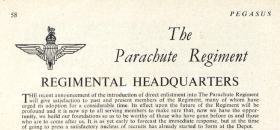In order to maintain continuity of airborne service and regularise anomalies existing since the Second World War, direct enlistment into the Parachute Regiment for other ranks was introduced in 1953. This was a notable change of status and terms of service for soldiers and later officers in the Parachute Regiment.
Anomalies stemmed from the large numbers of volunteers for service with the Parachute Regiment that had been accepted from officers and men of all arms and corps. Territorial and wartime soldiers had been transferred to the Army Air Corps as also Regular Soldier volunteers from corps other than infantry. They had meanwhile remained on the permanent strength of their own parent regiments, even though some were often promoted to senior ranks within the Parachute Regiment establishment.
Direct enlistment introduced in 1953 resolved the issue. The transfer of volunteers was accepted and men could enlist directly into the Regiment from civil life for the first time.
Officers continued to serve on secondment terms until 1958, when a regular cadre of officers was approved and the first transfers effected. In August 1958 Second Lieutenant RD Penley was the first officer to be directly commissioned into the Parachute Regiment from RMA Sandhurst.
Even after this date a proportion of the Parachute Regiment’s establishment was retained for volunteer secondments; although this is proportionally insignificant today.
Other arms and services within British Airborne Forces have continued to be manned by officers and soldiers from parent corps serving secondment tours, which have in some cases lasted many years.
All these measures were designed to retain a degree of continuity in the development and retention of the peculiar technical, tactical and specialist skills required of British airborne forces.
Direct Enlistment
Newsletter Signup
Donate
Donate
Make a donation to Airborne Assault ParaData to help preserve the history of The Parachute Regiment and Airborne Forces
The Airborne Shop
The Airborne Shop
The Airborne Shop is the official shop of Support Our Paras (The Parachute Regiment Charity RCN1131977).
Profits from all sales made through our shop go directly to Support Our Paras, so every purchase you make with us will directly benefit The Parachute Regiment and Airborne Forces.






Latest Comments
There are currently no comments for this content.
Add Comment
In order to add comments you must be registered with ParaData.
If you are currently a ParaData member please login.
If you are not currently a ParaData member but wish to get involved please register.